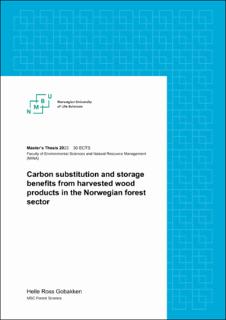| dc.description.abstract | The objective of this thesis was to study the carbon substitution and storage benefits from harvested wood products (HWPs) produced by the Norwegian forest industry today and potentially in the future. Five different product portfolios, scenarios, were considered.
Information about the carbon substitution factors and end-uses of the HWPs were acquired from various sources. Monte Carlo analysis were conducted for calculation of the substitution benefits for both production and use, and the end-of-life stages. To calculate the storage benefits, methods applied by the Intergovernmental Panel on Climate Change regulations and production data were used.
Scenarios 1 and 2 were defined based on forest sector production statistics. For scenario 1 the average HWP production for the five years 2017 to 2021 was used, while for scenario 2 the 2021 production was used. In scenario 3, recently established or confirmed production capacity investments in Norway were added to the production of HWPs in 2021. For scenario 4, also non-confirmed capacity investment plans aired by the potential investors were added. In scenario 5, the exported wood in scenario 3 was used for domestic production of HWPs with increased carbon substitution factors and longer life spans.
Scenario 5 had the greatest substitution and storage benefits of all scenarios. However, the recently established or confirmed production capacity in scenario 3 also increased the carbon substitution benefit substantially compared to previous production capacity defined in scenarios 1 and 2. The carbon sink decreased for all scenarios over time. Paper products and textiles experience the fastest decline due to their rapid oxidation time. The results also revealed that the production and use stage contributed more to the carbon substitution benefit than the end-of-life stage in all scenarios. This was especially apparent in scenario 4 which had the largest share of biofuels and pellets, with no substitution benefit in the end-of-life stage due to incineration during the production and use stage. All mean substitution benefits were significantly different between all the pairs of scenarios. The carbon sink ranged from 0.42 Mt C02 to 1.31 Mt C02 for the different scenarios in 2030.
The substitution benefits are indirectly included in the GHG reporting due to the avoided emissions as the result of use of HWPs. To illustrate how much emissions are avoided by substitution benefit, it should be calculated and considered, as it is important for policymakers to develop more effective policies for effectively mitigating climate change. Calculating substitution benefits would also help to plan climate-smart use of the available wood resources. | |
